Bengaluru: Scientists from China have successfully cloned a healthy rhesus monkey that has managed to survive without developmental defects for over two years — a first.
The cloning was done with the aid of somatic or non-sexual cells such as skin or organ cells, just like Dolly the sheep, the first mammal cloned.
So far, only one study had reported the successful cloning of a rhesus monkey, but the animal did not survive beyond a few hours.
The cloning was pulled off by scientists from the Chinese Academy of Sciences, and is significant because the rhesus monkey is physiologically similar to human beings. Successful cloning of these monkeys can aid drug development, besides other advances in medical science, as well as research into animal behaviour, even though the science of cloning remains controversial over ethical concerns surrounding it.
For their experiment, the Chinese scientists analysed genetic datasets of monkeys that were formed by natural IVF and those that were cloned, and discovered abnormalities in the development of some genes in the cloned embryo and the placenta it is housed in.
They then developed a method to address the problem, which allowed them to create ‘ReTro’ the monkey.
The details of the study were published Tuesday as a paper in the journal Nature Communications.
Also Read: No animal testing, human volunteers—how new-age ‘in silico’ trials will make drugs cheaper
Somatic cell nuclear transfer
Cloning is the process of making a genetically identical copy of an organism.
While Dolly was the first mammal to be cloned, she was not the first animal to undergo the process. She was preceded by many tadpoles and frogs, and attempts on other mammals.
Cloning has been taking place since 1885.
One of the basic ways to perform this is to separate the nucleus of one somatic cell and transplanting it into an egg cell from which the nucleus has been removed. This produces genetically identical copies of the original somatic cell. This is called somatic cell nuclear transfer or SCNT.
While SCNT is the most common, and even standard, technique for cloning, it has a low success rate, with experiments resulting in early deaths and lack of viable embryos. This has been particularly pronounced in primates. The only other cloned rhesus monkey survived for barely 12 hours in 2022.
Providing a healthy placenta for a cloned mammal embryo has been a challenge with the method, as SCNT placentas tend to become thicker and contain defects.
To understand why, the Chinese team compared 484 SCNT embryos and their placentas with 499 embryos from traditional in-vitro fertilisation. They found that, during development, the placenta that a cloned embryo is placed in develops abnormalities due to structural change of DNA called methylation.
The authors of the paper then developed a method to solve the placenta problem by replacing the outer layers of the tiny SCNT embryo, called trophoblast, with cells from regular IVF embryos. This led to the development of a healthy placenta, and the cloned embryos then developed within their placenta, which had become similar to the IVF placenta.
The team produced 113 cloned embryos of rhesus monkeys and transplanted 11 of them into seven surrogate female monkeys, ultimately resulting in two pregnancies. One of the fetuses developed into twins that died in gestation, while the other became the healthy male, ReTro.
This method is expected to prove promising for primate cloning.
Cloning and ethics
There are strong ethical debates around cloning, especially of mammals, both inside and outside the scientific community. While germline cloning creates a change in the DNA of an organism that can be transferred down to descendants, somatic cloning does not.
Many proponents of somatic-cell engineering, which involves modifying non-reproductive cells in adult humans to treat existing conditions, remain cautious about germline engineering.
Among mammals, apart from Dolly the sheep and ReTro, many other animals like rabbits, lambs, cows, goats, other types of monkeys, pigs, wolves, deer, horses, dogs, and cats, have been cloned successfully, albeit with a low survival rate. The very first primate was cloned six years ago.
(Edited by Sunanda Ranjan)
Also Read: How Ian Wilmut’s work on Dolly the sheep shaped cloning & stem cell research



